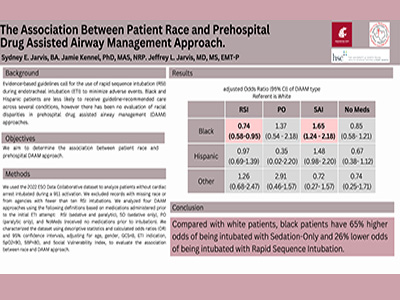ABSTRACTS
Association Between Gender, Ethnicity, and Termination of Resuscitation Efforts and Nontransport of Cardiac Arrest VictimsAuthor: Hezedean Smith, Paul Banerjee, and Olawale O. Akogun | | Associate Authors:
Introduction: Protocols for terminating resuscitation in prehospital settings vary. Limited research has explored the association between gender, ethnicity, termination of resuscitation, and nontransport of cardiac arrest victims in prehospital care. Understanding diversity and equity in prehospital care is crucial for fire and emergency services in the 21st century. Objective: To determine if an association exists between gender, ethnicity, and termination of resuscitation and nontransport of cardiac arrest victims in an urban/suburban fire-based EMS system in Florida. Methods: A quantitative method retrospectively analyzed data from 2020 to 2022. The dependent variables were the incident patient disposition codes Other Disposition (patients who received care but did not fit into other categories), Patient Treated and Transported, Patient Treated and Transferred Care, and Not Transported (patients declared dead at the scene with or without resuscitation attempts). The independent variables were gender and ethnicity. Chi-square tests were used to examine the association between patient disposition and gender and ethnicity. Results: The study analyzed 3140 cardiac arrest cases. White patients accounted for 68% (n = 2121) of the sample and non-White for 32% (n = 1019). Males comprised 62% (n = 1937) of the sample and females 38% (n = 1195). With regard to incident patient disposition, 23% (736) were Not Transported and 77% (2404 cases) were Other Disposition. Chi-square test results, with an alpha value of .05, indicated a significant association between incident patient disposition and gender (χ2 (3) = 14.34, p = .002). No significant association was found between incident patient disposition and ethnicity (χ2 (1) = 0.12, p = .729). Conclusion: Gender was significantly associated with termination of resuscitation and nontransport, whereas ethnicity was not. Most patients were categorized under Other Disposition, possibly indicating transport or transfer to another EMS agency. Future research should explore whether gender, ethnicity, or age predicts termination of resuscitation, considering system protocols as a critical inclusion criterion.
|

